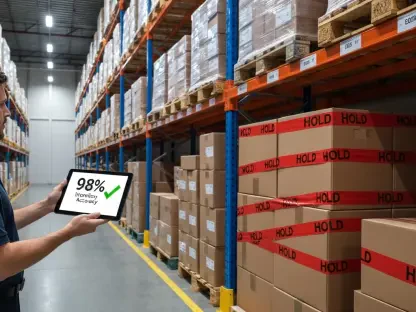The global transport and logistics industry, instrumental in the smooth operation of international trade, faces a range of challenges including geopolitical tensions and environmental issues. Although the industry critically relies on supply chain insurance, there is a noticeable shortage of suitable insurance products, coupled with a lack of sufficient risk data. This disconnect reveals a significant weakness that endangers global trade. To address this, there is an urgent need for better insurance solutions tailored for the logistics sector, ensuring that trade can withstand the myriad of risks it encounters. The industry must pivot towards a new strategy that improves insurance coverage, thereby protecting the vital arteries of commerce.
Assessing Current State of Logistics Sector and Risks
The transport and logistics landscape is rife with challenges that imperil its operational integrity. Companies grapple with a complex matrix of risks—sustainability demands, labor market fluxes, technological leaps, and geopolitical shifts are just some adversities that demand deft navigation. While some firms exhibit adept risk management protocols, others lag conspicuously, exhibiting the uneven risk preparedness across the industry. The stakes are high; inadequate strategies may culminate in compromised supply chains, underscoring an urgent need for a more harmonized approach to risk mitigation.Notwithstanding the varying maturity levels of risk management across the board, these risks do not discriminate. As the quest for ESG compliance intensifies, businesses are propelled towards greener operations, inadvertently sensitizing them to novel susceptibilities. Concurrently, digital transformation initiatives are reshaping industry norms, exacerbating cyber threat exposure and galvanizing the need for potent digital defense mechanisms.
Spotlighting Critical Supply Chain Risks
Undeniably, the surge in sustainability and ESG adherence is propelling companies towards drastic reconfigurations in their operational ethos. The pursuit of greener supply chains is no longer ancillary but rather a central determinant of industry viability—sustainability is now interwoven with corporate survival. And as businesses relentlessly chase technological innovation, leveraging IoT, AI, and cloud solutions to saliently elevate operations, the cybersecurity dimension inevitably escalates, revealing sobering vulnerabilities in a digitized supply chain continuum.These progressive shifts, although necessary, unleash intricate risks that plague the industry. Logistics enterprises grapple with bolstering their cybersecurity fortifications while pioneering eco-conscious transitions, balancing their forward momentum with risk aversion. The call to action is clear – escalate sustainability without compromising security, an endeavor that mandates prudent, forward-thinking strategies.
Unpacking Industry Trends and Their Impacts
E-commerce’s ascent has set new precedents for the logistics sector, demanding expedited delivery services that are rapidly reshaping the industry’s delivery methods. Digital innovation, too, is ever-present, with sophisticated systems enhancing transparency and efficiency. Yet, these advancements are not impervious to the whims of climate volatility; events like extreme weather present stark reminders of the transport and logistics sector’s fragility, underscoring the necessity for resolute resilience plans.The consequence of neglecting these imperatives is stark. As the climate narrative unfolds with increased inclemency, the necessity for robust responses grows more acute. Adapting to these evolving realities isn’t simply about staying competitive—it’s about survival. Logistics providers must anticipate, respond, and fortify their networks against these burgeoning threats, ensuring their place within the shifting tapestry of global trade.
The Challenge of Insurance Coverage in Logistics
Despite a keen awareness of diverse risks, a shocking stratum of logistics firms report an insurance shortfall that fails to encapsulate the breadth and depth of supply chain complexities. The dearth of customized insurance solutions, complemented by a paucity of insightful data on risk assessment, presents a formidable barrier to securing organizational assets against disruptions. This chasm between risk realization and risk protection is a stark invitation for insurers to align closer with the transport and logistics sector, forging innovative products and leveraging emergent data for heightened supply chain transparency.The insurance inadequacy isn’t merely a pitfall—it’s an opening for the industry to trailblaze novel insurance paradigms that align meticulously with the logistics sector’s nuanced demands. Addressing this gap means crafting contracts that not only protect but also empower businesses to navigate the risk landscape with confidence and strategic acumen.
Advancing Collaboration for Risk Management
The clarion call to bridge the insurance gap resonates with a broader plea for heightened cooperation. Leveraging synergies between logistics operators, brokers, and insurers can gestate bespoke risk management solutions tailored to the needs of the sector. By unifying expertise and resources, the industry can cultivate a more dissected comprehension of challenges and innovate collective strategies to cushion supply chains against disruptions.It’s a collective imperative: better collaboration is not just advantageous for individual entities but essential for the stability of broader global trade mechanisms. Through partnerships, the industry can bolster its defenses against risks, ensuring that the critical veins of commerce remain unfettered by unforeseen disruptions. As industry luminaries advocate, these alliances are pivotal in reinforcing risk mitigation efforts, cementing the reliability and efficiency of global logistics.









